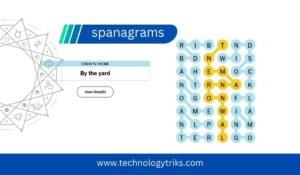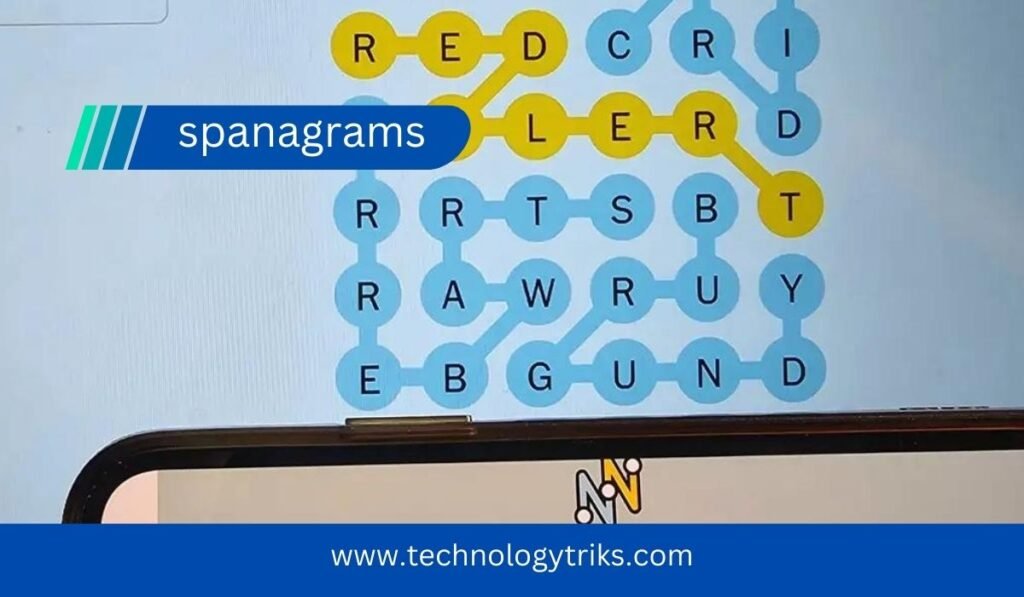Spanagrams are a kind of word puzzle in which letters are rearranged to create new words or phrases while nevertheless following particular restrictions. Spanagrams demand that the new word or phrase must also follow extra criteria, such containing a specific pattern or fitting within a thematic area, unlike conventional anagrams, where any rearranging of letters into a new word or phrase is allowed. Because of their extra level of intricacy, spangrams are a more difficult and interesting kind of word play.
Example:
First word: Dormitory
Anagram: Standard anagram Dirty Room
Spanagram: Must follow a theme categorization, for “words related to journals”.
Less often known is the term “spanagram,” and the puzzles themselves are sometimes found in specialized word game forums. Still, their capacity to mix imagination with reason is helping them to become more and more popular.
2. Spangram Origins and History
Although the precise source of the term “spanagram” is unknown, the idea stems from the larger history of anagrams, which have been rather popular for ages. From ancient times, anagrams have been employed in books, games, and even encryption. Natural development of word games, adding restrictions to anagrams to create spanagrams probably started as a new challenge for aficionados.
2.1. Anagrams in Historical Context
Anagrams originated in ancient Greece, where they were employed for a variety of uses including coded communication and puzzles. Lycophron, the poet, is said to have been among the first in literary works to employ anagrams. Anagrams were increasingly popular over time, especially in the Renaissance when academics and poets utilized them to highlight their wit and inventiveness.
2.2. Evolution into Spanagrams
Word games changed, and the move from basic anagrams to more complicated forms like spanagrams most certainly happened. Although the precise chronology is unknown, it is obvious that demand for more complex and difficult puzzles expanded as literacy rates raised and word puzzles gained popularity. With their added restrictions, spangrams offered a different approach to the classic anagram.
3. Methodologies and Advice for Creating Spanagrams
Making spanagrams demands both strategic thinking and artistic ability. There are multiple stages in the procedure, each one adding to the last puzzle.
The first step is selecting a base word.
Choosing a basis word or phrase comes first in building a spangram. Ideally, this word should have a moderate letter count since shorter words could provide few options while larger words can be more difficult to arrange.
- Base, for instance: Word: learning
- Third 2: Determine the constraint.
Find then the particular constraint or subject the spanagram has to follow. Starting with a particular letter, this could be a pattern; a thematic category (e.g., relating to food); or any other guideline adding complexity to the puzzle.
One of the constraints is that the spanagraph has to correspond to the learning theme.
- Third step: reorganize the letters.
Start rearranging the letters to create a fresh word or phrase keeping the underlying word and limitation in mind. Along with a solid vocabulary, this phase sometimes requires trial and error. - Base Word: Education spansagram example
Spanagram: A Cited No (following the learning theme since it might allude to the referencing of an academic work) - Third, fourth: validate the Spanagram.
At last, make sure the spangram makes sense given the selected restriction and that every letter from the original word is used exactly without duplication or omission.
Also read more: Cursed sea trello
4. Solving Spanagrams: Cognitive Advantages
Solving spanagram puzzles not only provides entertainment value but also some cognitive advantages. Cognitive psychology research has revealed that generally, word puzzles can improve brain function in several ways.
4.1. enhanced recall and memory
By forcing the brain to remember and manipulate various letter combinations, regularly solving word puzzles including spanagrams will increase memory and recall. This activity activates memory and language related brain circuits.
Regular word puzzle enthusiasts showed better memory and cognitive speed than those who did not according to a University of Exeter study.
4.2. Improved Solving of Problems
Spanagrams challenge participants to use strategic thinking and critical thinking, abilities applicable to many spheres of life. Finding patterns, weighing several options, and choosing the best answer helps improve general capacity to solve problems.
4.3. Language Development
Spanagraphs can be a great aid for younger people or non-native speakers developing their language. They inspire one to investigate novel words and phrases, therefore broadening their vocabulary and knowledge of language construction.
Word games like spanagrams can boost vocabulary memory by up to 20% in youngsters aged 8–12, claims a National Literacy Trust analysis.
5. Popular Spangram Problems and Their Answers
Simple to very sophisticated spangrams are possible. Here are several well-known instances together with their fixes.
| Base Word | Constraint | Spanagram |
|---|---|---|
| Listen | Must relate to sound | Silent |
| Astronomer | Must relate to space | Moon Starer |
| The Eyes | Must relate to vision | They See |
| Conversation | Must relate to communication | Voices Rant On |
These examples demonstrate the variety of constraints that can be applied to create engaging and challenging spanagrams.
6. Spanagrams in Modern Culture.
Despite the fact that spanagrams do not enjoy the same level of popularity as anagrams, they nevertheless find their way into many aspects of modern culture: literature, word online games, and educational materials.
6.1. Spanagrams and Literature
A number of writers and poets resort to spanagrams within their works only for the sake of word play. This helps to give a new dimension to their work and makes it attractive to those interested in word problems.
6.2. Online Word Games.
It is the popularity of online gaming that has further propagated the word puzzles like spanagrams to a wider audience. For instance, spanagram puzzles in Wordsmith and Lexulous allow users to compete against each other.
As recently as 2023, Wordsmith had over 2 million users who participated in the spanagram-related challenges, thus attesting to the form’s rising popularity.
6.3. Educational Tools.
Educators have also realized the potential of spanagrams as an educational tool. Teachers can utilize spanagrams in classroom activities to foster critical thinking among students while enhancing their linguistic talents.
One such example of classroom activity could be generating spanagrams with vocabulary terms so that students learn to master the meanings and spellings.
7. Common Myths and Misconceptions About Spanagrams
Like many word games, spanagrams are wrapped in myths and misconceptions. This chapter will address some of the more commonly encountered myths.
7.1 Myth 1: Spanagrams are really just anagrams in drag.
Although spanagrams are a type of anagram, they have the added requirement that they adhere to specific criteria. This added requirement makes them more challenging and different from purely an anagram.
7.2. Myth #2: Spanagrams Are Only for Language Experts
While spanagrams are notoriously complex, they should be within the reach of anyone possessing a rudimentary knowledge of the language. With conscientious practice, anyone will be able to design and solve them.
According to a study by Puzzle Nation, 65% of individuals who enjoy word puzzles but have never had any training in linguistics say they can solve spanagrams.
7.3. Myth 3: Spanagrams have no practical use.
Contrary to popular belief, spanagrams can be useful in many areas beyond just being a puzzle. They may be applied in educational settings, literary works, or in marketing campaigns for making memorable and interesting material.
8. Future of Spanagrams: Trends and Predictions
With a change in the word-puzzle game, the popularity of spanagrams is going to increase. This chapter evaluates various trends and predictions about the future of spanagrams.
8.1. Rise of Digital Games
With the coming of mobile apps and online games, the popularity of spanagrams is bound to rise. Game producers are likely to integrate spanagrams into their packages as a way of attracting consumers who love challenging puzzles.
8.2 Integration with Artificial Intelligence and Machine Learning.
In the future, spanningram generators that are AI-powered could be built with the advancement of AI and machine learning. This might give the user the ability to generate spanagrams in very fast and efficient ways, hence opening it up to even more users.
8.2 An AI-driven application may return a set of spanagrams which are possible on a given phrase and theme.
8.3 Adoption in Education.
Due to the cognitive benefits it offers, spanagrams will form part of more educational institutions’ curriculum. It can also make a case for the development of specialist instructional materials and resources centered on spanagram.
Tables and Data:
| Benefit | Description | Statistical Insight |
|---|---|---|
| Improved Memory | Regularly solving spanagrams can enhance memory and recall. | University of Exeter study: Improved memory in adults who engage in word puzzles. |
| Enhanced Problem-Solving Skills | Spanagrams require critical thinking and strategy, improving problem-solving abilities. | Word games increase cognitive function. |
| Language Development | Spanagrams expand vocabulary and language understanding. | National Literacy Trust: 20% increase in vocabulary retention in children. |
By understanding the intricacies of spanagrams and incorporating them into your daily routine, you can enjoy both the challenge and the cognitive benefits they offer. As this article has demonstrated, spanagrams are more than just a word puzzle; they are a tool for enhancing language skills, engaging the brain, and having fun.
9. Frequently Asked Questions (FAQs). About Spanagrams.
Q1: What is the difference between an anagram and a spanagram?
An anagram is a word or phrase whose letters have been remixed. A spanagram, however, is a type of anagram that is constrained by some particular rules, say, adhering to a theme or pattern.
Q2: Can anyone create a spanagram?
Yes, anyone knowing the rudimentary concepts of a language can make a spanagram. It does take a little while and practice to make spanagrams, but it can be an enjoyable pastime over time.
Q3: Are spanigrams used in professional capacity?
Though spanigrams are normally used for general amusement, they can still be used in teaching or advertising. They might be used to make the process of learning a language more fun, to engage an audience, or to create material that can be remembered.
Q4: How do I get better at solving spanagrams?
Solve spanagrams regularly. Develop your vocabulary, Try to solve difficult spanagrams.
Q5: Are there any online packages or sites which can be used to create Spanagrams?
Yes, there are several websites that provide online spanagram puzzles. Some of these include Wordsmith, Lexulous, etc. Practice using these and sharpen your skills.
Question 6: Can Spanagrams be used in cryptography?
While spanagrams are not usually used in cryptography, one may find them useful in specific contexts for coded communication since it works on patterns and limitations.
10. Conclusion:
Spanagrams Grow in Popularity.Spanagrams are a mixture of creativity, logic, and challenge and, thus, offer the exciting problem to be solved by any person at any age. Interest in word puzzles is on the rise, and it’s only a question of time before spanagrams are soon appearing everywhere in digital games, educational tools, and even professional applications. Be it the language expert or just the casual puzzle solver, Spanagrams offer a source of enjoyment and satisfaction.

